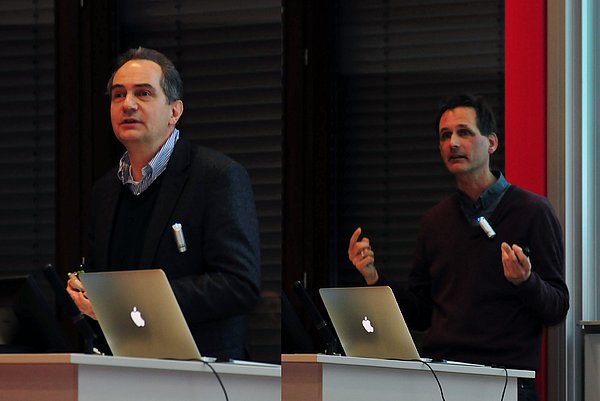Autonomous driving: Opportunity for sustainable mobility or "same same but different".
 Torsten Fleischer (l.) und Jens Schippl (r.), Karlsruhe Institute of Technology (KIT)
Torsten Fleischer (l.) und Jens Schippl (r.), Karlsruhe Institute of Technology (KIT)
The last lecture series of this semester was held on 10 January 2019 by Torsten Fleischer and Jens Schippl from the Institute for Technology Assessment and Systems Analysis (ITAS) of the Karlsruhe Institute of Technology (KIT). In their lecture, they gave the audience an insight into the topic of "Autonomous Driving" and the research questions that arise around the topic and are being investigated at ITAS.
Torsten Fleischer first briefly explained to the audience what technology assessment is and what it deals with. Technology assessment should help to answer problems and open questions that arise in connection with technology and technological change at an early stage. Among other things, ITAS provides orientation knowledge for the future design of socio-technical systems. Mr Fleischer vividly compared technology assessment with a combination of watchdog, sniffer dog and guinea pig.
Autonomous driving is part of a complex socio-technical system in which technical and social systems interact with each other in a variety of constantly changing forms, and its consequences are therefore also being investigated at ITAS.
At the beginning of the actual lecture, Mr. Fleischer gave an overview of the test vehicles currently in use. He pointed out that Autonomous Driving is by no means a new idea, but that the first experiments had already been carried out in the 1950s and 1980s. In contrast to today, however, the necessary technologies were not available at that time.
In autonomous driving, an image of the traffic environment is created with the aid of automation in the form of lidar, cameras and radar. Based on this machine perception, an understanding of the situation, action planning and finally path guidance must take place.
Vehicle automation is divided into four stages: semi-automated, highly automated, fully automated and driverless.
In the highly automated and fully automated stages, the transfer between driver and vehicle or between vehicle and driver is particularly problematic. Transfer and transfer strategies have to be developed here. Ironically, the driver is less and less involved in these stages, but in the event of an assignment has to take on more and more rare complex tasks, which he may no longer be able to cope with. It can even lead to a loss of vehicle control capability.
Autonomous driving faces both technical and social challenges. On the technology side, there are difficult to detect objects, difficult weather and road conditions, data management and energy requirements. In connection with the social system, the interpretation of non-standard behaviour patterns of other road users and the quality and differentiation of the classification of environmental information (e.g. age of road users) pose a challenge.
In addition, there is the question of how a vehicle should decide if personal injury cannot be avoided and to what extent society is willing to accept the limits of performance.
In the second part of the lecture Jens Schippl spoke about the effects of autonomous driving. Autonomous driving is expected to increase travel time, "new" road users, reduce costs and increase capacity. For example, road freight transport would become more attractive than rail transport, 60 % more vehicles could be parked in multi-storey car parks on the same area, and a move to rural areas could also become more attractive.
Mr. Schippl presented two possible scenarios for the future of autonomous driving based on two observations. On the one hand, it can be observed that especially young people in urban areas attach less importance to their own car and favour sharing concepts. On the other hand, there are still many autodominated urban transport systems, 40 million privately used cars and about 25% of new registrations are SUVs. Based on these observations, a scenario can be derived in which sharing and intermodality dominate and a scenario in which private and individual mobility predominates.
In conclusion, Mr. Schippl summarized that autonomous driving will come sooner or later, has enormous potential for change, and also harbours risks and opportunities for shaping the mobility system.
